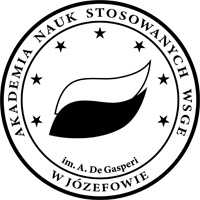Wydawnictwo
AWSGE
AWSGE

Akademia Nauk Stosowanych
WSGE
im. Alcide De Gasperi
WSGE
im. Alcide De Gasperi
BOOK CHAPTER (477-485)
Albanian women in stem: empowering human rights through communication
| 1 | Mediterranean University of Albania |
KEYWORDS
ABSTRACT
In the next decade, professions within Science, Technology, Engineering, and Mathematics (STEM) are expected to grow significantly. Yet, across Europe, and especially in Albania, a notable gender gap persists—particularly in Information and Communication Technology (ICT). This study explores how strategic communication can serve as a catalyst for change, empowering Albanian women to pursue and thrive in STEM careers and, in doing so, advancing gender equality and human rights.
Purpose of the study: Through a critical review of the representation of women in STEM, this study aims to identify effective mechanisms that encourage their active participation in these fields. Central to this approach is the use of communication as a transformative tool to challenge stereotypes and foster an inclusive environment.
Research shows that achieving gender parity in STEM education by 2050 could result in over 1.2 million new jobs and contribute between €610–820 billion to Europe’s GDP.
Research question: What are the communication-based and structural mechanisms that can reduce the underrepresentation of women in STEM in Albania and promote equity?
Hypothesis: To meet the challenges of the 21st-century knowledge economy, it is essential to eliminate gender, cultural, and social barriers, while empowering girls through inclusive communication, education, and supportive policies that enable more women to enter and remain in the STEM workforce.
REFERENCES (5)
1.
Hill, C., Corbett, C., & St. Rose, A. (2010). Why So Few? Women in Science, Technology, Engineering, and Mathematics. Washington, D.C.: American Association of University Women.
2.
INSTAT. (2020). Gender Equality Index for the Republic of Albania 2020, available at: http://www.instat.gov.al/media....
4.
Jiang, X. (2020). Women in STEM: Ability, Preference and Value, Ohio State University, available at: https://sites.google.com/site/....
5.
Kahn, S & Ginther, D, 2017. Women in STEM National bureau of economic research 1050Massachusetts Avenue Cambridge, MA 02138, available at, https://www.nber.org/system/fi....
We process personal data collected when visiting the website. The function of obtaining information about users and their behavior is carried out by voluntarily entered information in forms and saving cookies in end devices. Data, including cookies, are used to provide services, improve the user experience and to analyze the traffic in accordance with the Privacy policy. Data are also collected and processed by Google Analytics tool (more).
You can change cookies settings in your browser. Restricted use of cookies in the browser configuration may affect some functionalities of the website.
You can change cookies settings in your browser. Restricted use of cookies in the browser configuration may affect some functionalities of the website.





